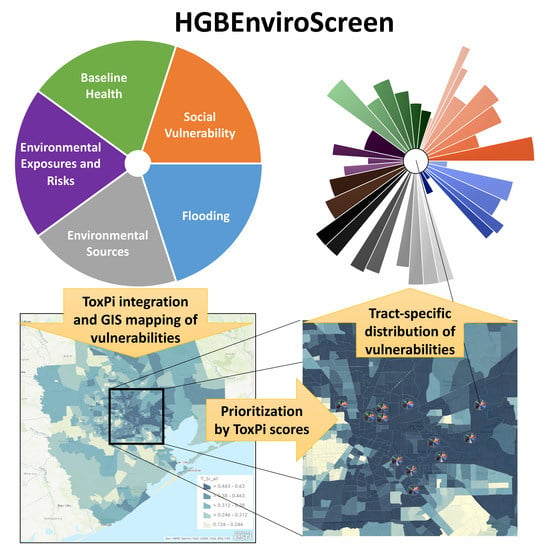HGBEnviroScreen: Enabling Community Action through Data Integration in the Houston–Galveston–Brazoria Region
Abstract
1. Introduction
2. Materials and Methods
- Social Vulnerability, as described by the Center for Disease Control (CDC), “refers to the resilience of communities when confronted by external stresses on human health”, particularly with respect to natural or human-caused disasters or disease outbreaks, and typically consists of socioeconomic and demographic factors. Social vulnerability is relevant to environmental vulnerability in the HGB area because of the prevalence of disasters, both natural (e.g., flooding and hurricanes) and manmade (e.g., chemical spills, oil spills, and fires). We included the four main themes (socioeconomic status, household composition and disability, minority and language, and housing and transportation) in addition to one auxiliary indicator (percent without health insurance) from the CDC’s Social Vulnerability Index (SVI) in our analysis. We also added three indicators related to food/nutrition access and security. Existing EJ screening tools typically include individual indicators of socioeconomic status, but we used SVI both because it provides a more comprehensive portrait of social vulnerability, as well as because it has been widely used and validated [16].
- Baseline Health uses indicators related to health status and health care access to capture the extent to which members of a community may be more vulnerable to effects from the environment, similar to the “sensitive population indicators” used in CalEnviroScreen [6]. Four of these indicators are of disease prevalence, specifically for coronary heart disease, stroke, childhood asthma, and chronic obstructive pulmonary disease, as estimated [17]. It is posited that higher rates of these diseases suggest a larger population that is more susceptible to the health impacts from environmental factors. Additionally, life expectancy is taken as an aggregate measure of baseline health, with lower values indicating greater vulnerability [18]. Finally, as a measure of access to health care, we counted the number of hospitals within 5 km of each census tract, again with lower numbers indicating greater vulnerability.
- Environmental Exposures and Risks utilize three well-established sources of indicators of pollutant exposures and risk. First, the EPA Risk-Screening Environmental Indicators provide a screening-level metric for the potential for chronic human health risks due to toxic releases from facilities that report to the Toxics Release Inventory (TRI) [19]. Additionally, we utilized the most recently available U.S. EPA National Air Toxics Assessment calculations for cancer risk, respiratory effects, and reproductive effects [20]. Third, we included two separate estimates of PM2.5 concentrations: one based on the last three years available from the U.S. EPA’s Community Multiscale Air Quality (CMAQ) model, [21] and one based on satellite imagery [22]. Each of these indicators is available at the census tract level.
- Environmental Sources are indicators related to the proximity of each census tract to sources of environmental emissions. Specifically, these indicators provide metrics for potential environmental exposure, rather than measured or predicted exposure or risk levels. A large number of different types of facilities were included. Point sources where exposure was expected to be more localized, such as Superfund sites and leaking petroleum storage tanks, were counted if located in each census tract. Industrial facilities such as cement batch plants and concrete crushers (combined), petroleum and oil refineries (combined), metal recyclers, and powerplants, where some transport of pollutants would be expected, were counted if within 1 km of each census tract. Additionally, proximity to major roads was also measured with a 1 km buffer distance. Finally, to incorporate indicators related to accident risks, facilities with registered Risk Management Plans were included using three metrics: facility counts, number of accidents in the five years before 30 April 2018, and total number of shelter-in-place events in the five years before 30 April 2018. These facilities were counted if located in each census tract.
- Flooding reflects risks related to inundation by floodwaters and includes both frequency and severity metrics. The recent history of frequent flooding in the HGB area emphasizes the importance of this domain to evaluating environmental vulnerability. The fractions of the census tract area within 100- and 500-year FEMA flood plains were used as frequency indicators. For severity, the number of FEMA damage assessments at various levels (minimal, major, affected, and destroyed), as well as the percentage of households filing damage claims, were used as indicators.
3. Results
3.1. Prioritization Across Census Tracts
3.2. Sensitivity Analysis: Primary Contributors to Vulnerability
3.3. Case Example: Galena Park
4. Discussion
5. Conclusions
- Incorporating data on key, multifaceted vulnerabilities, including both common EJ concerns such as social vulnerability and air pollution, as well as HGB-specific issues such as flooding and proximity to large numbers of industrial facilities;
- Aggregating five key domains of vulnerability into an overall ToxPi score at the census tract level, thereby facilitating identification and prioritization of highly vulnerable communities;
- Visualizing both the overall ToxPi score as well as the relative contribution of its component indicators, so as to enable communities to target advocacy and interventions that create the greatest value in terms of reducing vulnerability.
Supplementary Materials
Author Contributions
Funding
Acknowledgments
Conflicts of Interest
References
- United Church of Christ Commission for Racial Justice. Toxic Wastes and Race in the United States: A National Report on the Racial and Socio-Economic Characteristics of Communities with Hazardous Waste Sites; United Church of Christ Commission for Racial Justice: New York, NY, USA, 1987; p. 69. [Google Scholar]
- Bullard, R.D.; Wright, B.H. Environmental justice for all: Community perspectives on health and research needs. Toxicol. Ind. Health 1993, 9, 821–841. [Google Scholar] [CrossRef] [PubMed]
- Bethel, H.L.; Sexton, K.; Linder, S.; Abramson, S.; Bondy, M.; Fraser, M.; Ward, J. A Closer Look at Air Pollution in Houston: Identifying Priority Health Risks; Institute for Health Policy: Houston, TX, USA, 2006. [Google Scholar]
- Vojnovic, I. Governance in Houston: Growth Theories and Urban Pressures. J. Urban Aff. 2003, 25, 589–624. [Google Scholar] [CrossRef]
- Wilson, W.J. The Political and Economic Forces Shaping Concentrated Poverty. Political Sci. Q. 2008, 123, 555–571. [Google Scholar] [CrossRef]
- Faust, J.; Laura, A.; Komal, B.; Vanessa, G.; Julian, L.; Shankar, P.; Rose, S.; Andrew, S.; Robbie, W.; Walker, W.; et al. Update to the California Communities Environmental Health Screening Tool CalEnviroScreen 3.0; CalEPA: Sacramento, CA, USA, 2017. [Google Scholar]
- US EPA. EJSCREEN Technical Document; U.S. Environmental Protection Agency, Office of Policy: Washington, DC, USA, 2017. [Google Scholar]
- Rowangould, D.; Rowangould, G.; Craft, E.; Niemeier, D. Validating and Refining EPA’s Traffic Exposure Screening Measure. Int. J. Environ. Res. Public Health 2018, 16, 3. [Google Scholar] [CrossRef] [PubMed]
- Marvel, S.W.; To, K.; Grimm, F.A.; Wright, F.A.; Rusyn, I.; Reif, D.M. ToxPi Graphical User Interface 2.0: Dynamic exploration, visualization, and sharing of integrated data models. BMC Bioinform. 2018, 19, 80. [Google Scholar] [CrossRef] [PubMed]
- Reif, D.M.; Sypa, M.; Lock, E.F.; Wright, F.A.; Wilson, A.; Cathey, T.; Judson, R.R.; Rusyn, I. ToxPi GUI: An interactive visualization tool for transparent integration of data from diverse sources of evidence. Bioinformatics 2013, 29, 402–403. [Google Scholar] [CrossRef] [PubMed]
- Chiu, W.A.; Guyton, K.Z.; Martin, M.T.; Reif, D.M.; Rusyn, I. Use of high-throughput in vitro toxicity screening data in cancer hazard evaluations by IARC Monograph Working Groups. ALTEX 2018, 35, 51–64. [Google Scholar] [CrossRef] [PubMed]
- National Academies of Sciences, Engineering, and Medicine. Using 21st Century Science to Improve Risk-Related Evaluations; National Academies Press: Washington, DC, USA, 2017. [Google Scholar] [CrossRef]
- Loomis, D.; Guyton, K.; Grosse, Y.; El Ghissasi, F.; Bouvard, V.; Benbrahim-Tallaa, L.; Guha, N.; Mattock, H.; Straif, K. Carcinogenicity of lindane, DDT, and 2,4-dichlorophenoxyacetic acid. Lancet Oncol. 2015, 16, 891–892. [Google Scholar] [CrossRef]
- Zirogiannis, N.; Hollingsworth, A.J.; Konisky, D.M. Understanding Excess Emissions from Industrial Facilities: Evidence from Texas. Environ. Sci. Technol. 2018, 52, 2482–2490. [Google Scholar] [CrossRef] [PubMed]
- Tabuchi, H. High Levels of Carcinogen Found in Houston Area After Harvey. The New York Times, 9 June 2017. [Google Scholar]
- Flanagan, B.E.; Hallisey, E.J.; Adams, E.; Lavery, A. Measuring Community Vulnerability to Natural and Anthropogenic Hazards: The Centers for Disease Control and Prevention’s Social Vulnerability Index. Agency Toxic Subst. Dis. Regist. 2018, 80, 34–36. [Google Scholar]
- CDC. 500 Cities: Local Data for Better Health, 2017 Release; Centers for Disease Control and Prevention: Atlanta, GA, USA, 2018. [Google Scholar]
- USALEEP. U.S. Small-Area Life Expectancy Estimates Project; USALEEP: Silver Spring, MD, USA, 2018. [Google Scholar]
- TRI. TRI Basic Data Files: Calendar Years 1987–2017; EPA, Ed.; U.S. Environmental Protection Agency: Washington, DC, USA, 2019. [Google Scholar]
- US EPA. Chemical Concentrations, Exposures, Health Risks by Census Tract from National Scale Air Toxics Assessment (NATA); U.S. Environmental Protection Agency: Washington, DC, USA, 2017. [Google Scholar]
- US EPA. Community Multiscale Air Quality Modeling System: RSIG-Related Downloadable Data Files. Available online: https://www.epa.gov/hesc/rsig-related-downloadable-data-files (accessed on 5 April 2019).
- Di, Q.; Amini, H.; Shi, L.; Kloog, I.; Silvern, R.; Kelly, J.; Sabath, M.B.; Choirat, C.; Koutrakis, P.; Lyapustin, A.; et al. An ensemble-based model of PM2.5 concentration across the contiguous United States with high spatiotemporal resolution. Environ. Int. 2019, 130, 104909. [Google Scholar] [CrossRef] [PubMed]
- CDC. Social Vulnerability Index 2016 Database Texas. Available online: https://svi.cdc.gov/data-and-tools-download.html (accessed on 12 November 2019).
- CDC. Census Tract Level State Maps of the Modified Retail Food Environment Index (mRFEI). Available online: https://www.cdc.gov/obesity/downloads/census-tract-level-state-maps-mrfei_TAG508.pdf (accessed on 12 November 2019).
- USDA. Food Access Research Atlas Data. Available online: https://www.ers.usda.gov/data-products/food-access-research-atlas/download-the-data/ (accessed on 12 November 2019).
- Gundersen, C.; Dewey, A.; Crumbaugh, A.; Kato, M.; Engelhard, E. Map the Meal Gap 2018: A Report on County and Congressional District Food Insecurity and County Food Cost in the United States in 2016; Feeding America: Chicago, IL, USA, 2018. [Google Scholar]
- Texas DSHS. Texas Acute and Psychiatric Hospitals as of July 2019. Available online: https://dshs.texas.gov/chs/hosp/Hosplis2019.pdf (accessed on 12 November 2019).
- US EPA. Risk-Screening Environmental Indicators (RSEI) Model. Available online: https://www.epa.gov/rsei (accessed on 12 November 2019).
- Houston-Galveston Area Council. GIS Datasets. Available online: http://www.h-gac.com/gis-applications-and-data/datasets.aspx (accessed on 12 November 2019).
- City of Houston. Concrete Crusher, Cement Batch Processors, Metal Recycler Data; Lewis, G., Ed.; City of Houston: Houston, TX, USA, 2019. [Google Scholar]
- U.S. Energy Information Administration. Power Plants Shapefile. Available online: https://www.eia.gov/maps/map_data/PowerPlants_US_EIA.zip (accessed on 12 November 2019).
- TCEQ. TCEQ GIS Data. Available online: https://www.tceq.texas.gov/gis/download-tceq-gis-data (accessed on 12 November 2019).
- Houston Chronical. The Right-to-Know Network. Available online: http://www.rtk.net/ (accessed on 12 November 2019).
- Homeland Infrastructure Foundation-Level Data (HIFLD) Subcommittee. FEMA Modeled Building Damage Assessments Harvey 20170829. Available online: https://respond-harvey-geoplatform.opendata.arcgis.com/datasets/fema-modeled-building-damage-assessments-harvey-20170829/geoservice (accessed on 12 November 2019).
- Harris County Long Term Recovery Committee Data Workgroup. Coordinated Assistance Network (CAN) Data System; United Way: Houston, TX, USA, 2018. [Google Scholar]
- UCS. Houston Chemical Facilities Put Vulnerable Communities in Double Jeopardy; Union of Concerned Scientists: Cambridge, MA, USA, 2016. [Google Scholar]
- Brulle, R.J.; Pellow, D.N. Environmental justice: Human health and environmental inequalities. Annu. Rev. Public Health 2006, 27, 103–124. [Google Scholar] [CrossRef] [PubMed]
- Miranda, M.L.; Edwards, S.E.; Keating, M.H.; Paul, C.J. Making the environmental justice grade: The relative burden of air pollution exposure in the United States. Int. J. Environ. Res. Public Health 2011, 8, 1755–1771. [Google Scholar] [CrossRef] [PubMed]
- Tessum, C.W.; Apte, J.S.; Goodkind, A.L.; Muller, N.Z.; Mullins, K.A.; Paolella, D.A.; Polasky, S.; Springer, N.P.; Thakrar, S.K.; Marshall, J.D.; et al. Inequity in consumption of goods and services adds to racial-ethnic disparities in air pollution exposure. Proc. Natl. Acad. Sci. USA 2019, 116, 6001–6006. [Google Scholar] [CrossRef] [PubMed]
- US EPA. Environmental Equity Reducing Risk for All Communities; Epa-230-R-92-008; U.S. Environmental Protection Agency: Washington, DC, USA, 1992. [Google Scholar]
- Woo, B.; Kravitz-Wirtz, N.; Sass, V.; Crowder, K.; Teixeira, S.; Takeuchi, D.T. Residential Segregation and Racial/Ethnic Disparities in Ambient Air Pollution. Race Soc. Probl. 2019, 11, 60–67. [Google Scholar] [CrossRef] [PubMed]
- Morello-Frosch, R.; Pastor, M.; Porras, C.; Sadd, J. Environmental justice and regional inequality in southern California: Implication for future research. Environ. Health Perspect. 2002, 110, 149–154. [Google Scholar] [CrossRef] [PubMed]
- Driver, A.; Mehdizadeh, C.; Bara-Garcia, S.; Bodenreider, C.; Lewis, J.; Wilson, S. Utilization of the Maryland Environmental Justice Screening Tool: A Bladensburg, Maryland Case Study. Int. J. Environ. Res. Public Health 2019, 16, 348. [Google Scholar] [CrossRef] [PubMed]
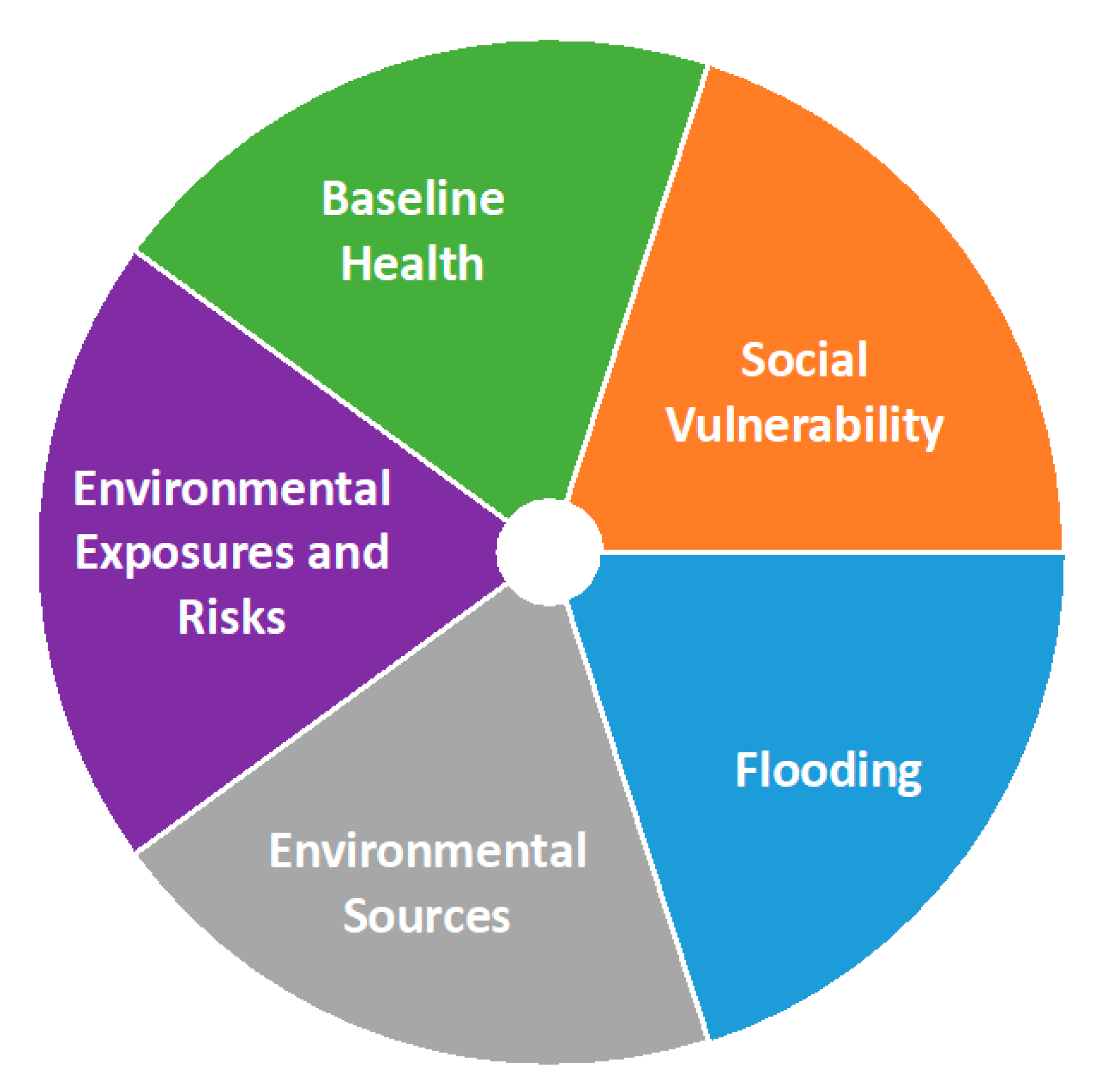
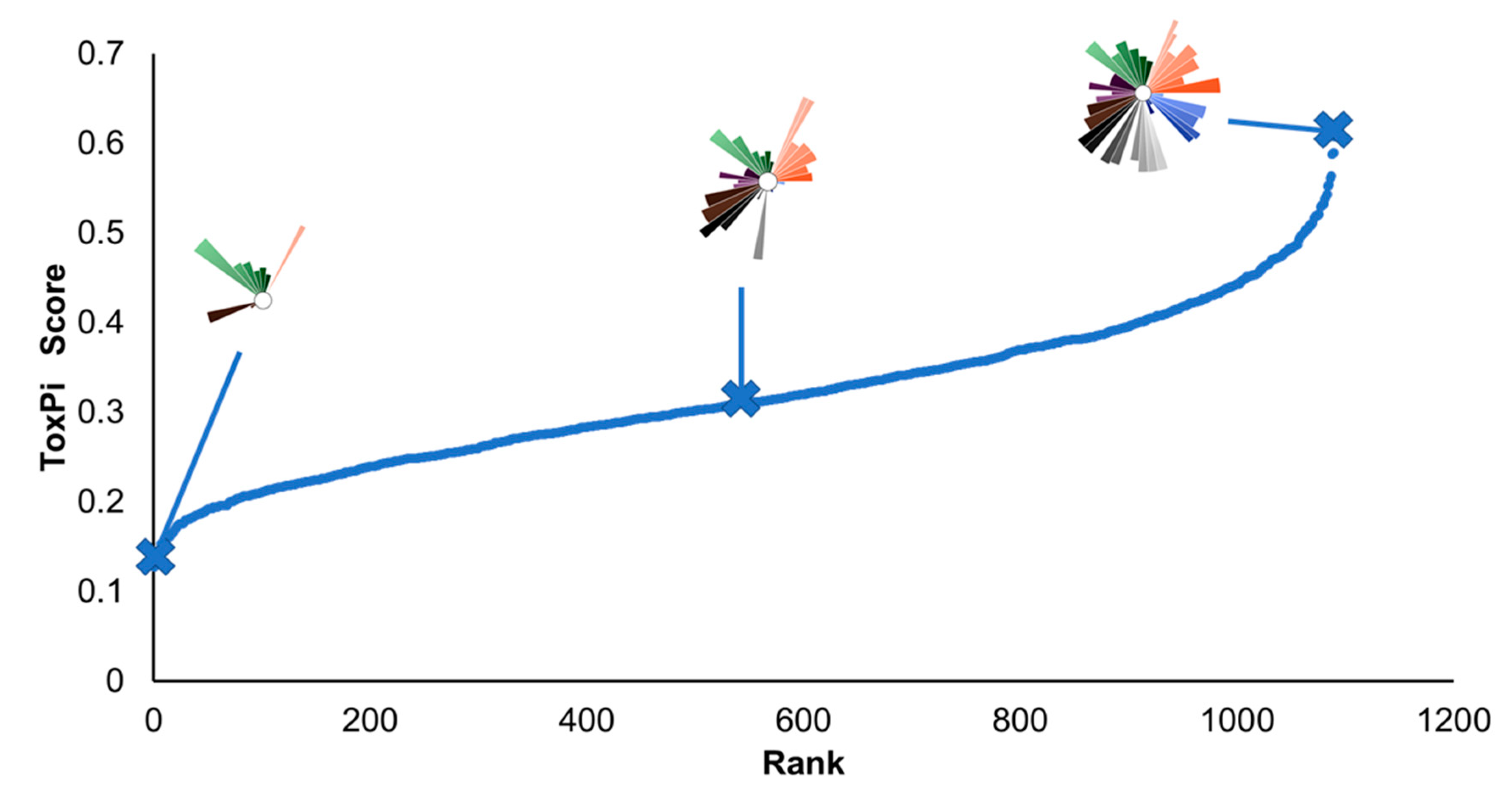
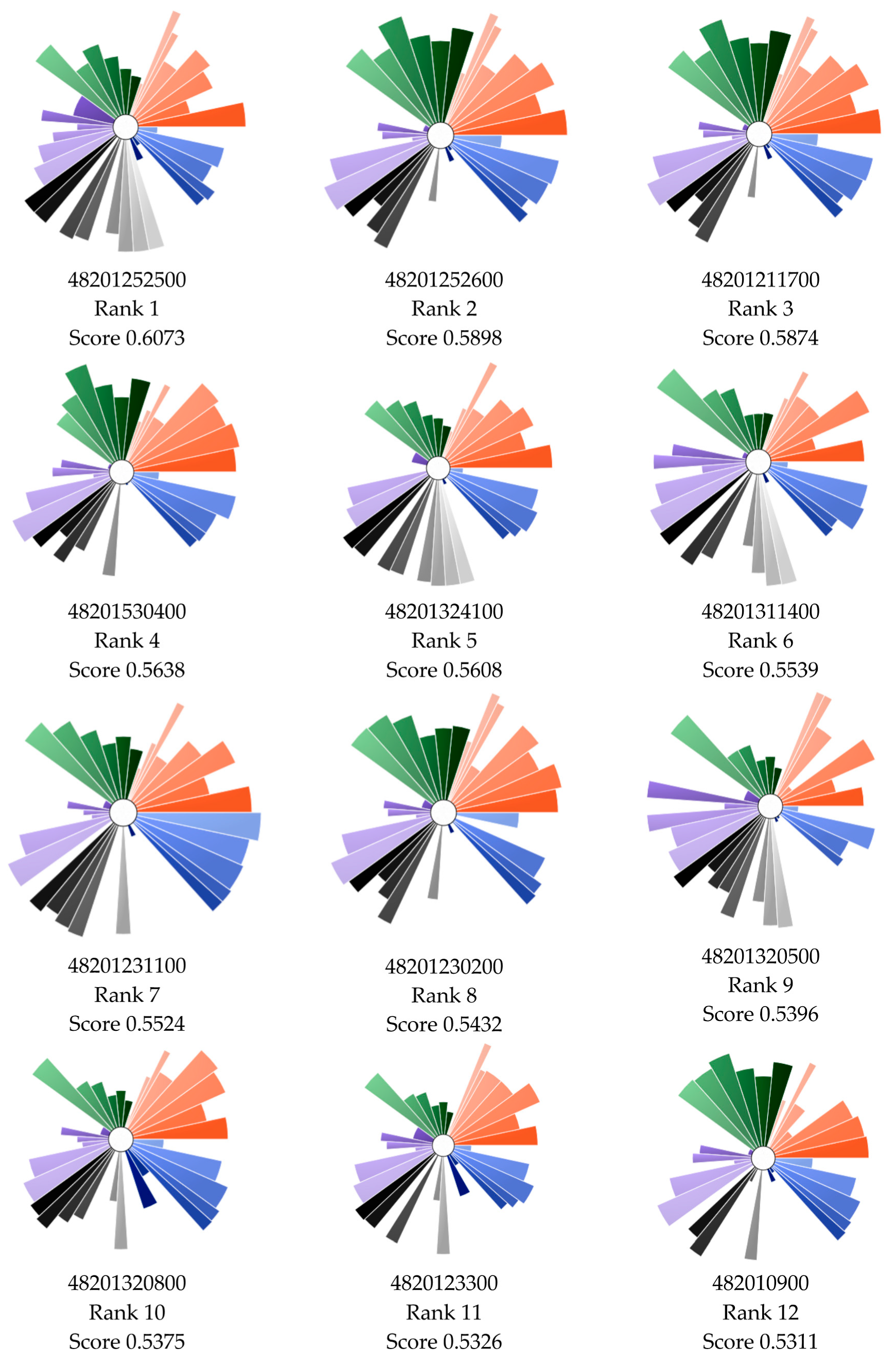
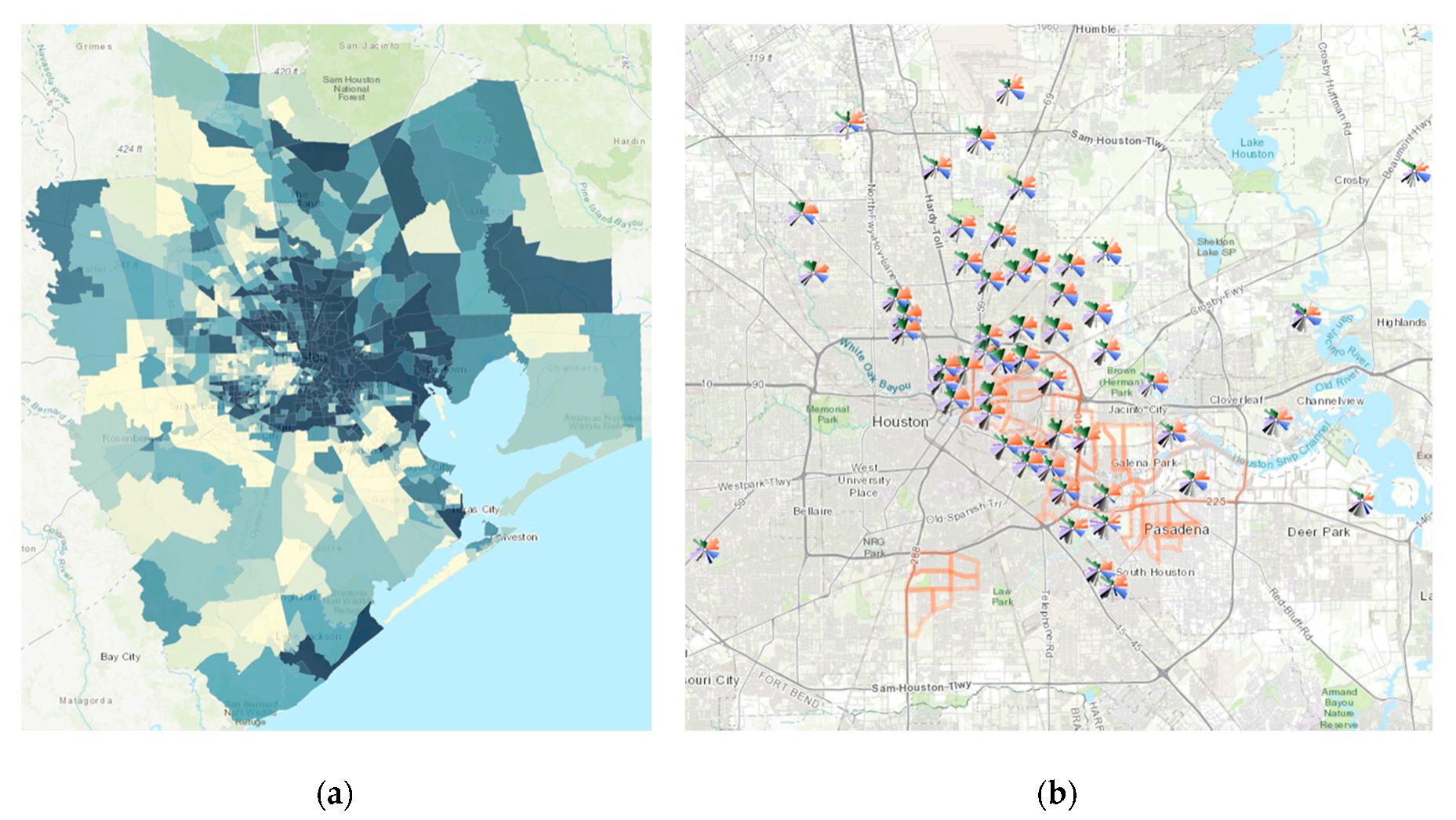

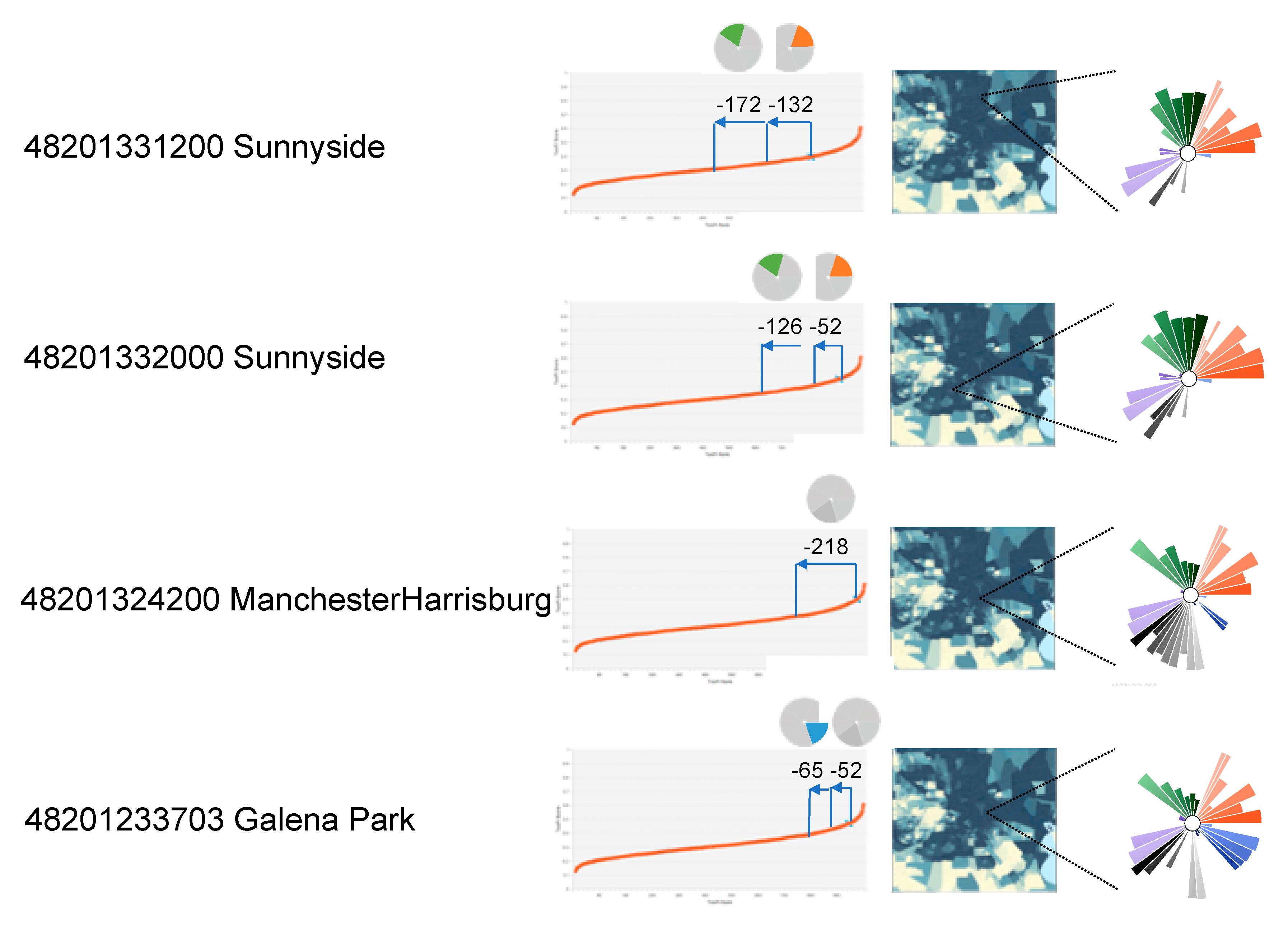
| Domain (% Weight of Overall Score) Indicator (Fractional Weight within Domain) | Indicator Unit for Each Census Tract | Ref. |
|---|---|---|
| Social Vulnerability (20%) | ||
| Socioeconomic status (1/6) | % ile index | [23] |
| Household composition and disability (1/6) | % ile index | [23] |
| Minority status and language (1/6) | % ile index | [23] |
| Housing and transportation (1/6) | % ile index | [23] |
| Without health insurance (1/6) | % of population | [23] |
| Modified food retail environment index (1/18) | 100—MFREI Score 1 | [24] |
| Food desert low access (1/18) | Sum of two low access flags | [25] |
| Low food security (1/18) | % of population | [26] |
| Baseline Health (20%) | ||
| Childhood asthma (1/6) | % crude prevalence | [17] |
| Stroke (1/6) | % crude prevalence | [17] |
| Chronic obstructive pulmonary disease (1/6) | % crude prevalence | [17] |
| Coronary heart disease (1/6) | % crude prevalence | [17] |
| Life expectancy (1/6) | 100—Life exp in years 1 | [18] |
| Proximity to hospitals (1/6) | 100—# within 5 km 1 | [27] |
| Environmental Exposures and Risks (20%) | ||
| Risk-screening environmental indicators (1/3) | Aggregated 2015–2017 Score | [28] |
| National Air Toxics Assessment (NATA) Cancer (1/9) | Cancer risk | [20] |
| NATA Respiratory Tract (1/9) | Hazard index | [20] |
| NATA Reproductive (1/9) | Hazard index | [20] |
| PM2.5 Community Multiscale Air Quality (CMAQ) (1/6) | μg/m3 | [21] |
| PM2.5 Satellite (1/6) | μg/m3 | [22] |
| Environmental Sources (20%) | ||
| Major roads (1/10) | % ile based on # within 1 km | [29] |
| Cement batch plants (1/10) | % ile based on # within 1 km | [30] |
| Metal recyclers (1/10) | % ile based on # within 1 km | [30] |
| Petrochemical and oil refineries (1/10) | % ile based on # within 1 km | [19] |
| Power plants (1/10) | % ile based on # within 1 km | [31] |
| Superfund sites (1/10) | % ile based on # in census tract | [32] |
| Leaking petroleum storage tanks (1/10) | % ile based on # in census tract | [32] |
| Facilities with risk management plans (RMP) (1/10) | % ile based on # in census tract | [33] |
| Accident events reported in RMP (1/10) | % ile based on # in census tract | [33] |
| Shelter-in-place events reported in RMP (1/10) | % ile based on # in census tract | [33] |
| Flooding (20%) | ||
| 100 year flood plain (1/6) | % ile based on fraction of area | [29] |
| 500 year flood plain (1/6) | % ile based on fraction of area | [29] |
| Harvey damage assessment “Affected” (1/12) | % ile based on # in census tract | [34] |
| Harvey damage assessment “Minimal” (1/12) | % ile based on # in census tract | [34] |
| Harvey damage assessment “Major” (1/6) | % ile based on # in census tract | [34] |
| Harvey damage assessment “Destroyed” (1/6) | % ile based on # in census tract | [34] |
| Families filing Harvey damage claims (1/6) | % of population | [35] |
© 2020 by the authors. Licensee MDPI, Basel, Switzerland. This article is an open access article distributed under the terms and conditions of the Creative Commons Attribution (CC BY) license (http://creativecommons.org/licenses/by/4.0/).
Share and Cite
Bhandari, S.; Lewis, P.G.T.; Craft, E.; Marvel, S.W.; Reif, D.M.; Chiu, W.A. HGBEnviroScreen: Enabling Community Action through Data Integration in the Houston–Galveston–Brazoria Region. Int. J. Environ. Res. Public Health 2020, 17, 1130. https://doi.org/10.3390/ijerph17041130
Bhandari S, Lewis PGT, Craft E, Marvel SW, Reif DM, Chiu WA. HGBEnviroScreen: Enabling Community Action through Data Integration in the Houston–Galveston–Brazoria Region. International Journal of Environmental Research and Public Health. 2020; 17(4):1130. https://doi.org/10.3390/ijerph17041130
Chicago/Turabian StyleBhandari, Sharmila, P. Grace Tee Lewis, Elena Craft, Skylar W. Marvel, David M. Reif, and Weihsueh A. Chiu. 2020. "HGBEnviroScreen: Enabling Community Action through Data Integration in the Houston–Galveston–Brazoria Region" International Journal of Environmental Research and Public Health 17, no. 4: 1130. https://doi.org/10.3390/ijerph17041130
APA StyleBhandari, S., Lewis, P. G. T., Craft, E., Marvel, S. W., Reif, D. M., & Chiu, W. A. (2020). HGBEnviroScreen: Enabling Community Action through Data Integration in the Houston–Galveston–Brazoria Region. International Journal of Environmental Research and Public Health, 17(4), 1130. https://doi.org/10.3390/ijerph17041130





